Search for Expression Marker Genes That Reflect the Physiological Conditions of Blossom End Enlargement Occurrence in Cucumber
Abstract
:1. Introduction
2. Results
2.1. Effects of CPPU on Fruit Growth
2.2. Effects of CPPU on the Occurrence of BEE
2.3. Gene Expression of Sugar Starvation-Related Genes
2.4. BEE Occurrence and Expression of CsSEF1 in MA Packaging Film
3. Discussion
4. Materials and Methods
4.1. Plant Materials
4.2. Effect of Postharvest CPPU Application on BEE Occurrence
4.3. Effect of Preharvest CPPU Application on BEE Occurrence
4.4. Effect of CPPU on Fruit Development
4.5. Effect of MA Packaging Film
4.6. Gene Expression Analysis
4.7. Statistical Analysis
5. Conclusions
Supplementary Materials
Author Contributions
Funding
Institutional Review Board Statement
Informed Consent Statement
Data Availability Statement
Acknowledgments
Conflicts of Interest
References
- Satitmunnaithum, J.; Muroi, H.; Ito, R.; Tashiro, Y.; Febri Hendratmo, A.; Tanabata, S.; Sato, T. Cultivation conditions affect the occurrence of blossom-end enlargement in cucumber. Hort. J. 2022, 91, 531–540. [Google Scholar] [CrossRef]
- Matsumoto, M.; Okada, I. Study to determine the cause of cucumber apex fattening phenomenon. Bull. Tonami Hortic. Branch. Stn. 1979, 15, 15–22. [Google Scholar]
- Okabayashi, H. Effect of storage temperature, fruit shape and modified atmosphere packaging on apex enlargement in cucumber [Cucumis sativus] fruits. Bull. Kochi Agric. Res. Cent. 2001, 10, 11–19. [Google Scholar]
- Igarashi, M.; Furuno, S.; Saito, K.; Suzuki, K. Studies on the generation factor of apex enlargement in cucumber fruits during the transportation and control method. Bull. Yamagata Hort. Res. 2005, 17, 39–45. [Google Scholar]
- Kato, R.; Oda, H. Studies on the physiological disorders in fruit vegetable crops under plastic films. VIII. On the occurrence of abnormal fruits in cucumber plants. (II) On the development of carrot type and bottle gourd type fruits, so-called sakibosori and shiributo fruits in Japan. Res. Rep. Kouchi Univ. (Agric. Sci.) 1977, 26, 175–182. [Google Scholar]
- Tazuke, A.; Asayama, M. Expression of CsSEF1 gene encoding putative CCCH zinc finger protein is induced by defoliation and prolonged darkness in cucumber fruit. Planta 2013, 237, 681–691. [Google Scholar] [CrossRef] [PubMed]
- Day, B.P.F. Modified atmosphere packaging of fresh fruit and vegetables—An overview. Acta Hort. 2001, 553, 585–590. [Google Scholar] [CrossRef]
- Manjunatha, M.; Anurag, R.K. Effect of modified atmosphere packaging and storage conditions on quality characteristics of cucumber. J. Food Sci. Technol. 2014, 51, 3470–3475. [Google Scholar] [CrossRef]
- Takahashi, S.; Shudo, K.; Okamoto, T.; Yamada, K.; Isogai, Y. Cytokinin activity of N-phenyl-N′-(4-pyridyl) urea derivatives. Phytochemistry 1978, 17, 1201–1207. [Google Scholar] [CrossRef]
- Qian, C.; Ren, N.; Wang, J.; Xu, Q.; Chen, X.; Qi, X. Effects of exogenous application of CPPU, NAA and GA4+7 on parthenocarpy and fruit quality in cucumber (Cucumis sativus L.). Food Chem. 2018, 243, 410–413. [Google Scholar] [CrossRef]
- Fu, F.Q.; Mao, W.H.; Shi, K.; Zhou, Y.H.; Yu, J.Q. Spatio-temporal changes in cell division, endoreduplication and expression of cell cycle-related genes in pollinated and plant growth substances-treated ovaries of cucumber. Plant Biol. 2010, 12, 98–107. [Google Scholar] [CrossRef] [PubMed]
- Tazuke, A.; Kinoshita, T.; Asayama, M. Expression of the BTB/POZ domain-containing protein AT1G63850-like gene CsFDI1 is enhanced by sugar starvation in cucumber fruit. Acta Physiol. Plant 2015, 37, 15. [Google Scholar] [CrossRef]
- Tazuke, A.; Kinoshita, T.; Asayama, M. The expression of a candidate cucumber fruit sugar starvation marker gene CsSEF1 is enhanced in malformed fruit induced by salinity. Physiol. Mol. Biol. Plants 2017, 23, 565–570. [Google Scholar] [CrossRef] [PubMed]
- Tazuke, A.; Kanisawa, K.; Kinoshita, T.; Asayama, M. Varietal differences in the effects of total defoliation on the expression of candidate marker genes of sugar starvation in cucumber fruit. Hort. Res. 2019, 18, 157–165. [Google Scholar] [CrossRef]
- Tazuke, A.; Kinoshita, T.; Asayama, M. Expression of candidate marker genes of sugar starvation is upregulated in growth-suppressed parthenocarpic cucumber fruit. Novel gene markers for sugar starvation in growth-suppressed cucumber fruit. Front. Plant Sci. 2023, 14, 1241267. [Google Scholar] [CrossRef]
- Tazuke, A.; Kinoshita, T. Analysis of the decline in respiration rate of cucumber fruits on vines under prolonged darkness, total defoliation, cutting, and heat-girdling of the peduncle. Hort. Res. 2018, 17, 55–59. [Google Scholar] [CrossRef]
- Grabowska, A.; Wisniewska, A.; Tagashira, N.; Malepszy, S.; Filipecki, M. Characterization of CsSEF1 gene encoding putative CCCH-type zinc finger protein expressed during cucumber somatic embryogenesis. J. Plant Physiol. 2009, 166, 310–323. [Google Scholar] [CrossRef] [PubMed]
- Bläsing, O.E.; Gibon, Y.; Günther, M.; Höhne, M.; Morcuende, R.; Osuna, D.; Thimm, O.; Usadel, B.; Scheible, W.R.; Stitt, M. Sugars and circadian regulation make major contributions to the global regulation of diurnal gene expression in Arabidopsis. Plant Cell 2005, 17, 3257–3281. [Google Scholar] [CrossRef]
- Contento, A.L.; Kim, S.J.; Bassham, D.C. Transcriptome profiling of the response of Arabidopsis suspension culture cells to Suc starvation. Plant Physiol. 2004, 135, 2330–2347. [Google Scholar] [CrossRef]
- Zhao, J.; Jiang, L.; Che, G.; Pan, Y.; Li, Y.; Hou, Y.; Zhao, W.; Zhong, Y.; Ding, L.; Yan, S.; et al. A functional allele of CsFUL1 regulates fruit length through repressing CsSUP and inhibiting auxin transport in cucumber. Plant Cell 2019, 31, 1289–1307. [Google Scholar] [CrossRef]
- Grumet, R.; Lin, Y.C.; Rett-Cadman, S.; Malik, A. Morphological and genetic diversity of Cucumber (Cucumis sativus L.) fruit development. Plants 2022, 12, 23. [Google Scholar] [CrossRef] [PubMed]
- Taiz, L.; Zeiger, E. Plant Physiology; Sinauer: Sunderland, UK, 2010; pp. 1–675. [Google Scholar]
- Nishizawa, T.; Okada, T.; Suzuki, Y.; Motomura, Y.; Aikawa, T. Postharvest deformation of cucumber fruit associated with water movement and cell wall degradation. Acta Hortic. 2018, 1194, 1217–1224. [Google Scholar] [CrossRef]
- Takeno, K.; Ise, H.; Minowa, H.; Dounowaki, T. Fruit growth induced by benzyladenine in Cucumis sativus L.: Influence of benzyladenine on cell division, cell enlargement and indole-3-acetic acid content. J. Jpn. Soc. Hortic. Sci. 1992, 60, 915–920. [Google Scholar] [CrossRef]
- Hirama, N.; Mizusawa, H.; Azuhata, F.; Matsuura, S. Culture methods to reduce the occurrence of the bottle-gourd-shaped fruits in the greenhouse of fall-cropped cucumber plants. Hort. Res. 2007, 6, 65–70. [Google Scholar] [CrossRef]
- Shishido, Y.; Hori, Y.; Shikano, S. Effects of benzyl adenine on translocation and distribution of photoassimilates during fruit setting and development in cucumber plants. J. Jpn. Soc. Hortic. Sci. 1990, 59, 129–136. [Google Scholar] [CrossRef]
- Kojima, K.; Murata, Y. IAA concentration and polar transport in cucumber fruit. Bull. Fac. Agric. Niigata Univ. 2023, 75, 1–5. [Google Scholar]
- Sapers, G.M.; Gorny, J.R.; Yousef, A.E. (Eds.) . Microbiology of Fruits and Vegetables; CRC Press: Boca Raton, FL, USA, 2005. [Google Scholar] [CrossRef]
- Sun, M.; Wang, M.; Lu, H.; Yu, Q.; Yuan, S.; Guo, Y.; Yao, W.; Yu, H. Coupling dynamics of respiration, gas exchange, and Pseudomonas fluorescens growth on fresh-cut cucumber (Cucumis sativus L.) in passive modified atmosphere packing. Food Res. Int. 2023, 173, 113306. [Google Scholar] [CrossRef] [PubMed]
- Katsumi, M. Physiological effects of kinetin. Effect of kinetin on the elongation, water uptake and oxygen uptake of etiolated pea stem sections. Physiol. Plant 1963, 16, 66–72. [Google Scholar] [CrossRef]
- Dedolph, R.R.; Wittwer, S.H.; Tuli, V. Senescence inhibition and respiration. Science 1961, 135, 1075. [Google Scholar] [CrossRef]
- Tetley, R.M.; Thimann, K.V. The metabolism of oat leaves during senescence: I. respiration, carbohydrate metabolism, and the action of cytokinins. Plant Physiol. 1974, 54, 294–303. [Google Scholar] [CrossRef]
- Liu, X.; Hao, N.; Li, H.; Ge, D.; Du, Y.; Liu, R.; Wen, C.; Li, Y.; Zhang, X.; Wu, T. PINOID is required for lateral organ morphogenesis and ovule development in cucumber. J. Exp. Bot. 2019, 70, 5715–5730. [Google Scholar] [CrossRef] [PubMed]
- Wang, D.H.; Li, F.; Duan, Q.H.; Han, T.; Xu, Z.H.; Bai, S.N. Ethylene perception engages in female cucumber flower development. Plant J. 2010, 61, 862–872. [Google Scholar] [CrossRef] [PubMed]
- Gao, J.; Zhang, Y.; Li, Z.; Liu, M. Role of ethylene response factors (ERFs) in fruit ripening. Food Qual. Saf. 2020, 4, 15–20. [Google Scholar] [CrossRef]
- Kanda, Y. Investigation of the freely available easy-to-use software ‘EZR’ for medical statistics. Bone Marrow Transplant. 2013, 48, 452–458. [Google Scholar] [CrossRef] [PubMed]
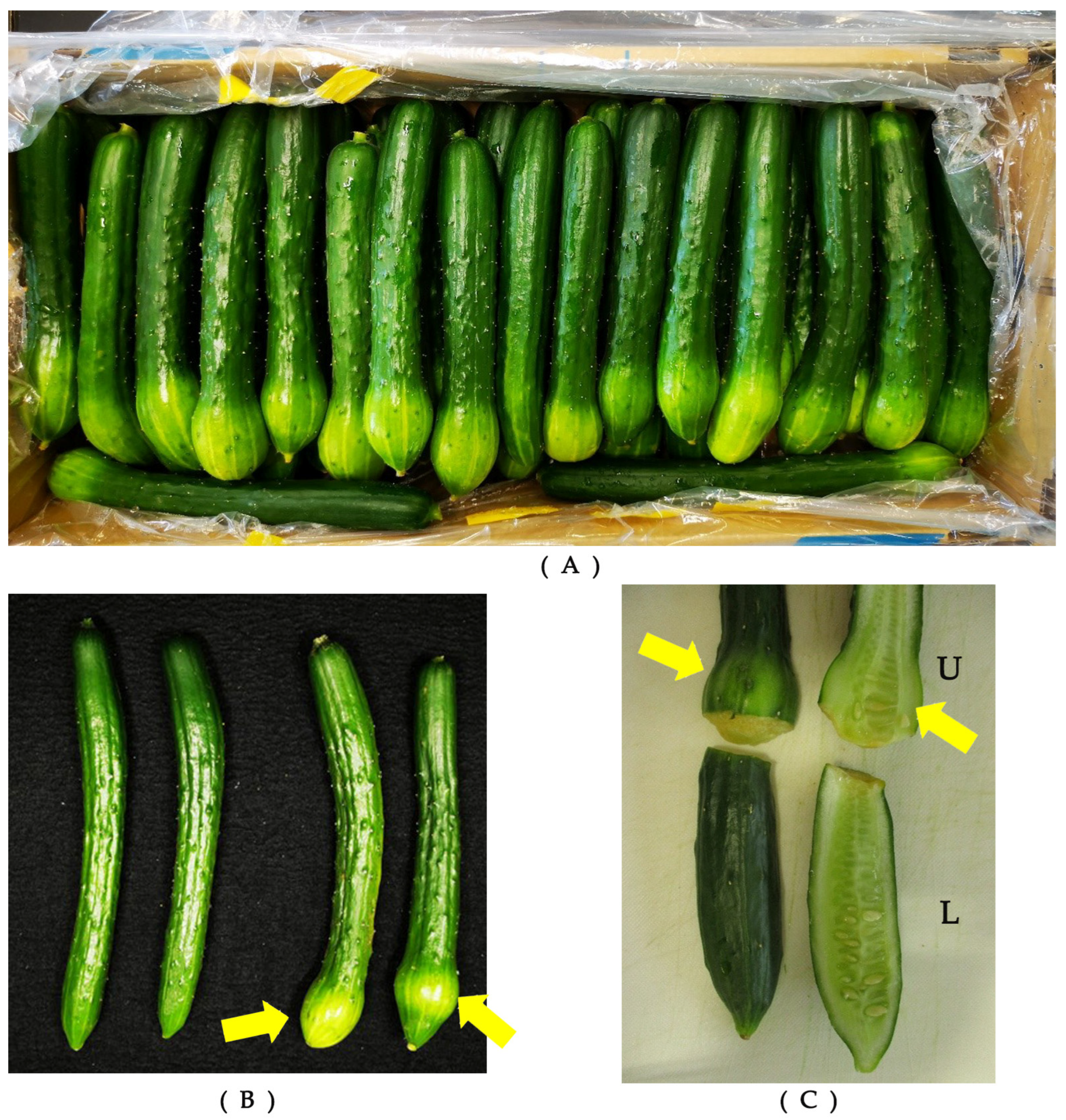
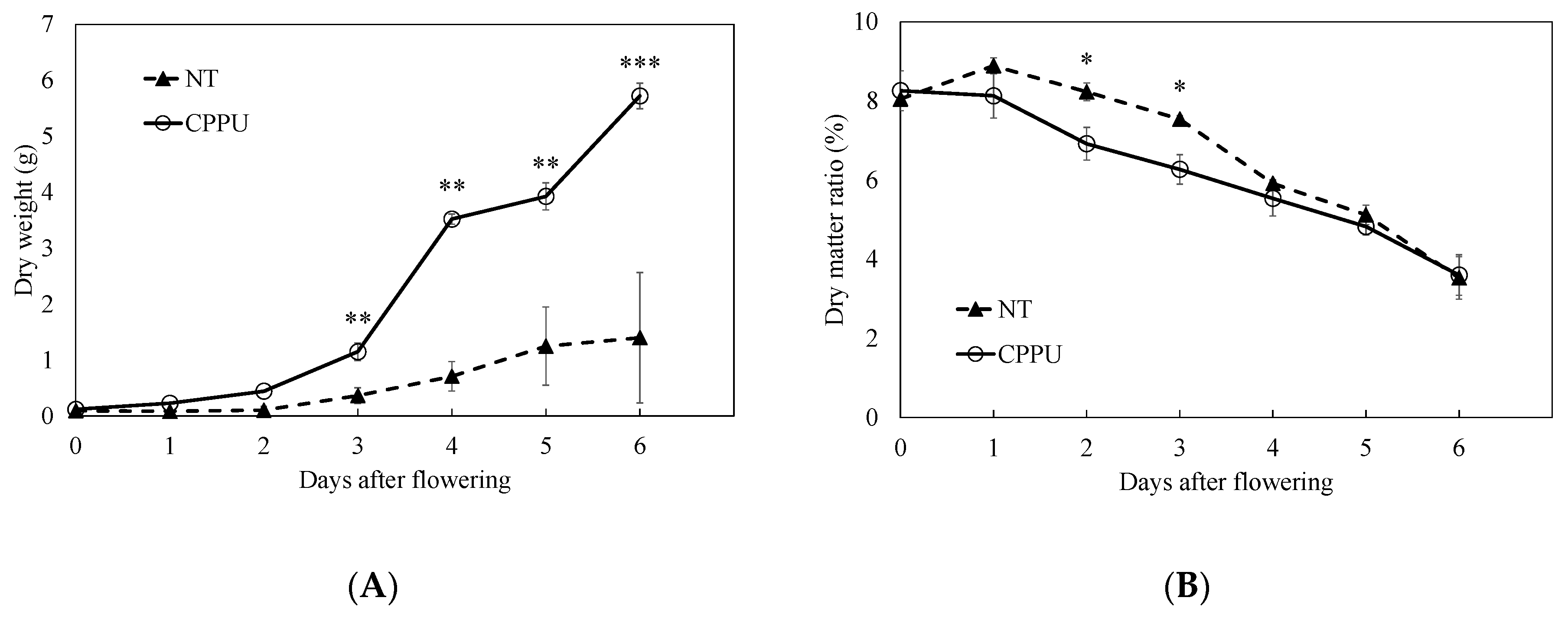
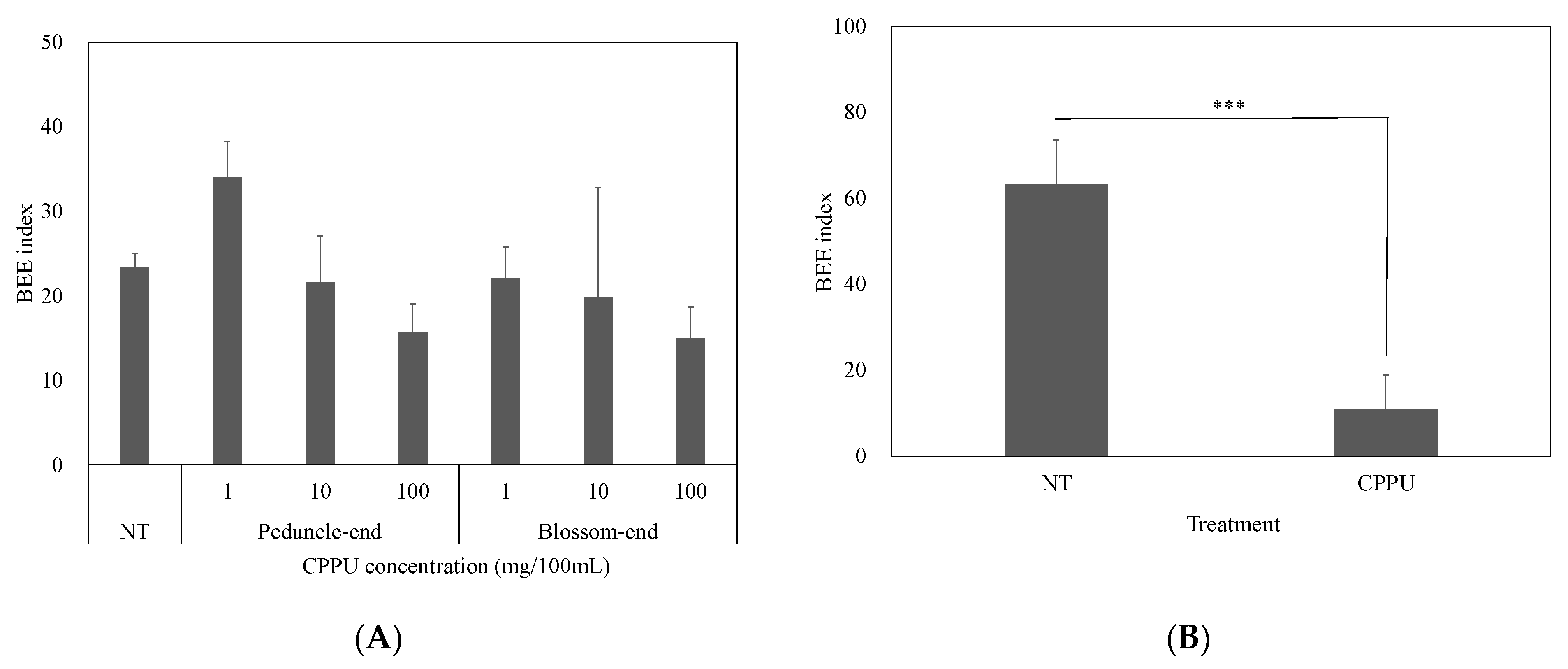
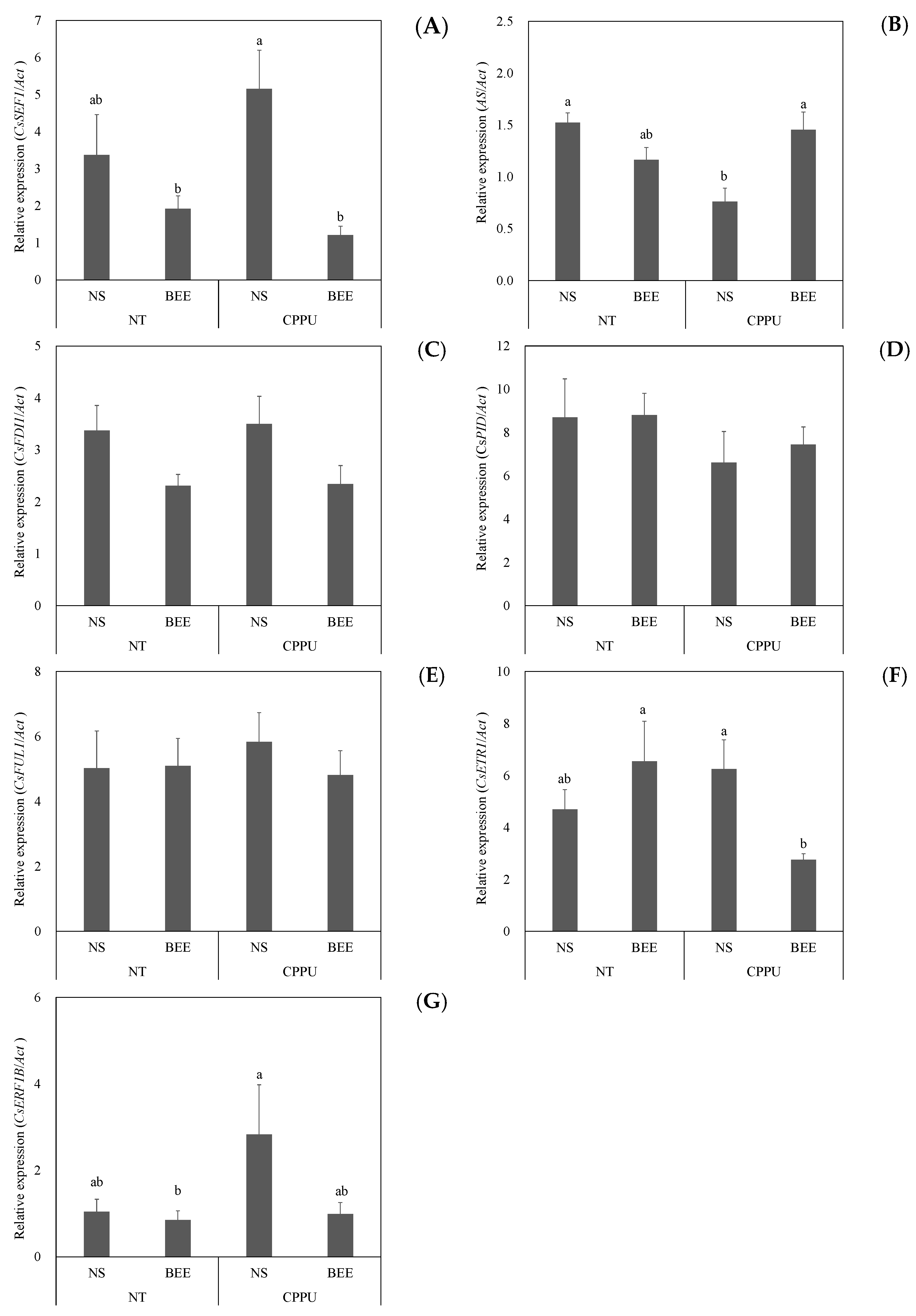

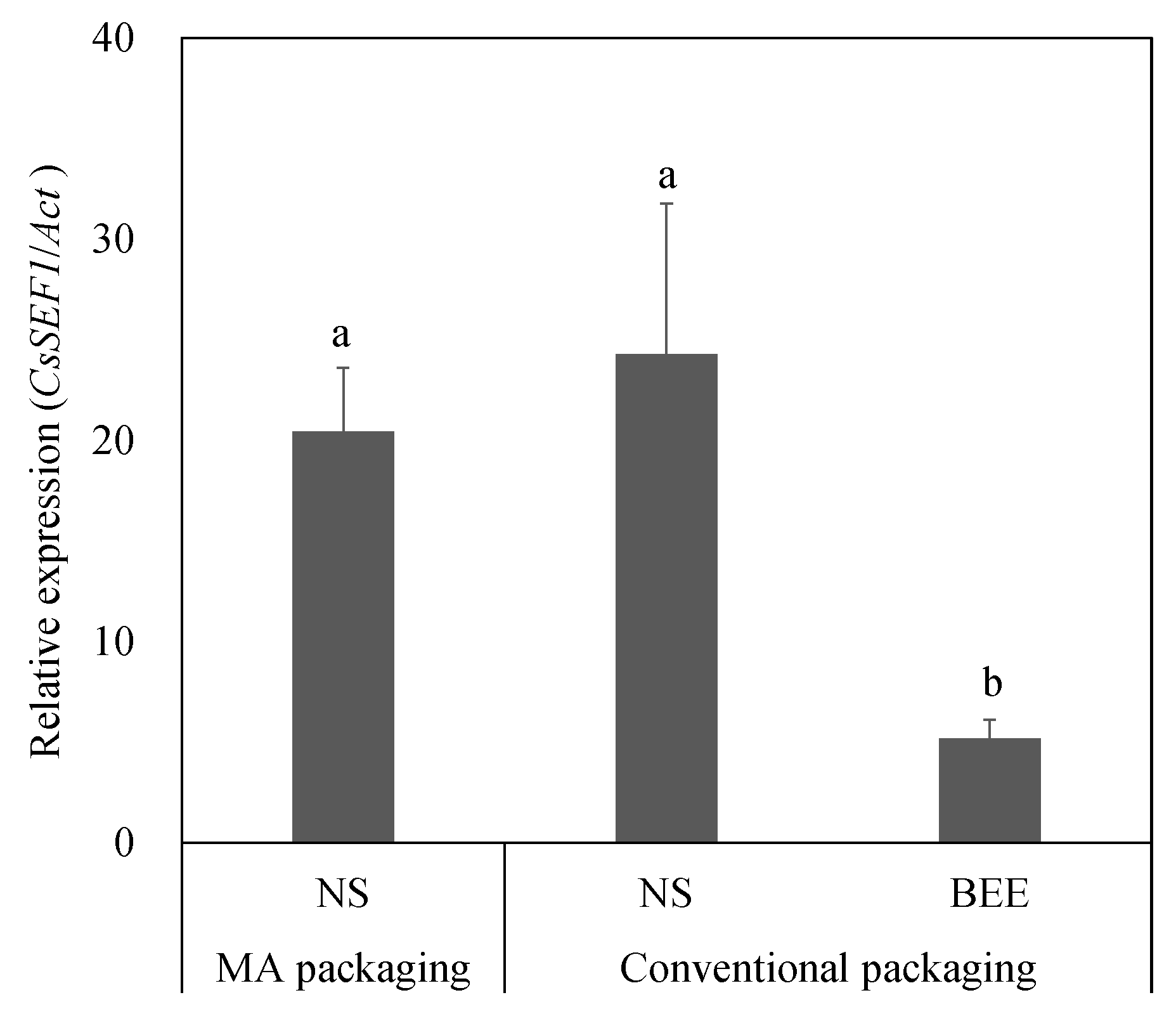
| Abbreviation in GenBank | Description in GenBank | Primer Sequence |
|---|---|---|
| CsActa AB698859.1 | Cucumis sativus mRNA for actin, cultivar: Shimoshirazu jibai. | F 5’-TCTGTCCCTCTACGCTAGTGGAC-3’ R 5’-TCCAAACGGAGAATGGCATGAGG-3’ |
| CsSEF1 AJ870303.1 | Cucumis sativus mRNA for putative CCCH-type zinc finger protein | F 5’-AGACCGATACCGGACTCAAC-3’ R 5’-TGTGAGCGAAGAAACAGACC-3’ |
| AS XM_004143115.3 | PREDICTED: Cucumis sativus asparagine synthetase | F 5’-TGAGGGTTCACCAGATTTGA-3’ R 5’-AATGGCATCAATCCCATCTT-3’ |
| CsFDI1 XM_031888327.1 | PREDICTED: Cucumis sativus BTB/POZ domain-containing protein At1g63850-like, transcript variant X1 | F 5’-AATGCCCTCTTCAGCACTCT-3’ R 5’-GAGGAAATGTTGCAGGGATT-3’ |
| CsPID XM_031882167.1 | PREDICTED: Cucumis sativus protein PIN-LIKES 7-like | F 5’-TCCATCGGCATTATGACTGAGC-3’ R 5’-ATCCACATGAAGAGTGTATACC-3’ |
| CsFUL1 XM_011652029.2 | PREDICTED: Cucumis sativus truncated transcription factor CAULIFLOWER A, transcript variant X2 | F 5’-GGCAAAAAGATAAAGGAGAAGGAG-3’ R 5’-ATGCTAAGAGATTGAAATGGCTGA-3’ |
| CsETR1 NM_001280633.1 | Cucumis sativus ethylene receptor 1-like | F 5’-AACTCTTGTGGCAGTGGTCT-3’ R 5’-GTAGCCGTGCATCCCTTTCC-3’ |
| CsERF1B XM_004134020.3 | PREDICTED: Cucumis sativus ethylene-response factor C3 | F 5’-TGCATTCATCTCCCCGCTTT-3’ R 5’-GGTGAAGGAGGATTCGGGTG-3’ |
Disclaimer/Publisher’s Note: The statements, opinions and data contained in all publications are solely those of the individual author(s) and contributor(s) and not of MDPI and/or the editor(s). MDPI and/or the editor(s) disclaim responsibility for any injury to people or property resulting from any ideas, methods, instructions or products referred to in the content. |
© 2024 by the authors. Licensee MDPI, Basel, Switzerland. This article is an open access article distributed under the terms and conditions of the Creative Commons Attribution (CC BY) license (https://creativecommons.org/licenses/by/4.0/).
Share and Cite
Li, R.; Atarashi, R.; Kharisma, A.D.; Arofatullah, N.A.; Tashiro, Y.; Satitmunnaithum, J.; Tanabata, S.; Yamane, K.; Sato, T. Search for Expression Marker Genes That Reflect the Physiological Conditions of Blossom End Enlargement Occurrence in Cucumber. Int. J. Mol. Sci. 2024, 25, 8317. https://doi.org/10.3390/ijms25158317
Li R, Atarashi R, Kharisma AD, Arofatullah NA, Tashiro Y, Satitmunnaithum J, Tanabata S, Yamane K, Sato T. Search for Expression Marker Genes That Reflect the Physiological Conditions of Blossom End Enlargement Occurrence in Cucumber. International Journal of Molecular Sciences. 2024; 25(15):8317. https://doi.org/10.3390/ijms25158317
Chicago/Turabian StyleLi, Rui, Runewa Atarashi, Agung Dian Kharisma, Nur Akbar Arofatullah, Yuki Tashiro, Junjira Satitmunnaithum, Sayuri Tanabata, Kenji Yamane, and Tatsuo Sato. 2024. "Search for Expression Marker Genes That Reflect the Physiological Conditions of Blossom End Enlargement Occurrence in Cucumber" International Journal of Molecular Sciences 25, no. 15: 8317. https://doi.org/10.3390/ijms25158317






